高三英语全英文教案
英语教案范文全英文版高中

英语教案范文全英文版高中一、IntroductionObjective: To introduce and practice mon English phrases and expressions used in dly life.Materials: Flashcards with pictures and words, worksheets. Procedure:1. Greetings and warm-up: Ask students to introduce themselves and practice mon greetings.2. Presentation: Show flashcards with pictures and words, and ask students to guess the meaning of each word. Then, practice the phrases and expressions together.3. Practice: Divide students into groups and give them worksheets with exercises to practice the phrases and expressions.4. Consolidation: Ask students to role-play conversations using the phrases and expressions they have learned.二、Vocabulary BuildingObjective: To expand students' vocabulary introducing new words and phrases related to a specific topic.Materials: Flashcards with pictures and words, worksheets, realia. Procedure:1. Introduce the topic and ask students to guess the meaning of the new words and phrases.2. Presentation: Show flashcards with pictures and words, and ask students to match the words with their meanings. Then, practice the words and phrases together.3. Practice: Give students worksheets with exercises to practice the new words and phrases.4. Consolidation: Ask students to create sentences using the new words and phrases, and present them to the class.三、Listening and SpeakingObjective: To improve students' listening and speaking skills practicing dialogues and conversations.Materials: Audio recording, worksheets.Procedure:1. Ask students to listen to an audio recording and answer some questions about it.2. Presentation: Play the audio recording and ask students to repeat after the speaker. Then, practice the dialogues and conversations together.3. Practice: Divide students into prs or groups and give them worksheets with exercises to practice the dialogues and conversations.4. Consolidation: Ask students to role-play the dialogues and conversations with a partner or group, and then present them to the class.四、Reading and WritingObjective: To improve students' reading and writing skills analyzing and summarizing a text.Materials: Text, worksheets.Procedure:1. Ask students to read a text and answer some questions about it.2. Presentation: Discuss the text with students, and ask them to identify the mn ideas and supporting detls. Then, practice summarizing the text together.3. Practice: Give students worksheets with exercises to practice reading and writing skills, such as fill in the blanks, true or false, and matching.4. Consolidation: Ask students to write a summary of the text, and then present it to the class.五、Grammar ReviewObjective: To review and practice a specific grammar point. Materials: Worksheets, realia.Procedure:1. Review the grammar point and ask students to identify examples of the grammar rule in a text.2. Presentation: Expln the grammar rule and give students examples to practice. Then, practice the grammar point together.3. Practice: Give students worksheets with exercises to practice the grammar point.4. Consolidation: Ask students to create sentences using the grammar point, and present them to the class.六、Grammar FocusObjective: To focus on a specific grammar point and practice it through various activities.Materials: Worksheets, realia, flashcards.Procedure:1. Introduce the grammar point and ask students to identify examples in a given text.2. Presentation: Expln the grammar rule using flashcards, realia, and examples. Practice the grammar point together.3. Practice: Divide students into prs or groups and give them worksheets with exercises focusing on the grammar point.4. Consolidation: Ask students to create sentences using the grammar point in a real-life context and present them to the class.七、Listening ComprehensionObjective: To improve students' listening prehension skills understanding and interpreting audio materials.Materials: Audio recording, worksheets.Procedure:1. Ask students to listen to an audio recording and answer some pre-listening questions.2. Presentation: Play the audio recording and ask students to take notes. Discuss the content and answer prehension questions.3. Practice: Give students worksheets with exercises based on the audio recording, such as multiple choice, true or false, and fill in the blanks.4. Consolidation: Ask students to summarize the audio recording in their own words and present it to the class.八、Speaking SkillsObjective: To enhance students' speaking skills through discussions, presentations, and role-plays.Materials: Worksheets, realia, flashcards.Procedure:1. Introduce the topic and ask students to express their opinions on the subject.2. Presentation: Provide students with prompts or questions related to the topic and facilitate a class discussion.3. Practice: Divide students into prs or groups and give them worksheets with speaking activities, such as role-plays and presentations.4. Consolidation: Ask students to present their speaking activities to the class and provide feedback on each other's performances.九、Writing SkillsObjective: To develop students' writing skills pleting different types of writing tasks.Materials: Worksheets, realia, writing prompts.Procedure:1. Introduce the writing task and provide students with a prompt or topic.2. Presentation: Expln the writing process and provide examples of the desired writing style. Guide students through the writing process.3. Practice: Give students worksheets with writing exercises, such as essays, reports, or letters.4. Consolidation: Ask students to share their written pieces with the class and provide feedback on each other's work.十、Cultural AwarenessObjective: To enhance students' cultural awareness and understanding through the study of English-speaking cultures.Materials: Worksheets, realia, audio recordings, videos.Procedure:1. Introduce the cultural topic and ask students to share their prior knowledge.2. Presentation: Provide information about the cultural topic using audio recordings, videos, realia, and worksheets. Discuss and pare the cultural aspects with students' own culture.3. Practice: Give students worksheets with activities related to the cultural topic, such as crossword puzzles, quizzes, or short essays.4. Consolidation: Ask students to reflect on the cultural topic and share their thoughts and experiences. Encourage a class discussion and promote cultural exchange.十一、Project WorkObjective: To apply the knowledge and skills learned in previous lessons to a group project.Materials: Project materials, worksheets.Procedure:1. Introduce the project topic and expln the objectives. Divide students into groups.2. Presentation: Provide guidelines and instructions for the project. brnstorm ideas and give examples.3. Practice: Allow students to work on their projects, providing support and guidance as needed.4. Consolidation: Ask students to present their projects to the class and provide feedback on each other's work.十二、Exam PreparationObjective: To prepare students for an uping exam reviewing key concepts and practicing exam questions.Materials: Exam review worksheets, past exam papers.Procedure:1. Expln the purpose of the lesson and review the exam format.2. Presentation: Go over key concepts and provide examples. Discuss exam strategies and tips.3. Practice: Give students exam review worksheets or past exam papers to practice.4. Consolidation: Conduct a mock exam or review session, allowing students to ask questions and clarify doubts.十三、Error CorrectionObjective: To help students identify and correct mon errors in their writing.Materials: Sample student essays, error correction worksheets. Procedure:1. Expln the importance of error correction and its role in improving writing skills.2. Presentation: Provide students with sample student essays contning mon errors. Discuss the errors and their corrections.3. Practice: Give students error correction worksheets to identify and correct errors in sample sentences or paragraphs.4. Consolidation: Encourage students to peer-edit each other's writing and provide feedback on errors.十四、Extension ActivitiesObjective: To provide additional practice and challenge for students who need further development.Materials: Extension worksheets, online resources.Procedure:1. Expln that these activities are optional and designed for students who want extra practice or a challenge.2. Presentation: Provide an overview of the extension activities and expln how to plete them.3. Practice: Allow students to work on the extension activities at their own pace, providing support as needed.4. Consolidation: Encourage students to share their pleted extension activities with the class and discuss their experiences.十五、Classroom Management and ReviewObjective: To review the lessons learned and evaluate student progress. Materials: Progress charts, self-assessment worksheets.Procedure:1. Ask students to reflect on what they have learned and their progress in the course.2. Presentation: Review key concepts, vocabulary, and skills covered in the course. Discuss any challenges or areas for improvement.3. Practice: Give students self-assessment worksheets to evaluate their own progress and identify areas they want to focus on.4. Consolidation: Conduct a class review session, allowing students to ask questions and clarify doubts. Discuss strategies for ongoingimprovement and provide feedback on student progress.重点和难点解析本文主要介绍了一篇高中英语教案范例,涵盖了从问候、词汇学习、听力与口语、阅读与写作、语法复习到项目工作、考试准备、错误纠正、拓展活动、课堂管理与复习等多个方面的教学内容。
新人教版英语高三全册教案-Lesson Framework

新人教版英语高三全册教案-LessonFramework1. Introduction本教案旨在为高三学生提供一套完整的英语教学框架,以新人教版教材为基础。
此教案旨在帮助学生掌握课文内容,提高阅读、听力、口语和写作技能。
2. 教学目标- 帮助学生正确理解和运用课文中的主要词汇和语法结构- 培养学生的听力技巧,提高听力理解能力- 提高学生的口语表达能力,培养他们的自信心- 增强学生的阅读理解能力,并培养他们的写作能力3. 教学内容本教案覆盖全册的教学内容,按照课文顺序进行安排。
每节课的教学内容包括以下几个方面:3.1. 课前准备- 预热活动:通过一些有趣的活动引起学生的兴趣,激发他们研究的动力。
预热活动:通过一些有趣的活动引起学生的兴趣,激发他们学习的动力。
- 词汇导入:介绍本课文中的重点词汇和短语,帮助学生理解课文内容。
词汇导入:介绍本课文中的重点词汇和短语,帮助学生理解课文内容。
3.2. 听力训练- 听力材料:播放与课文相关的录音材料,要求学生仔细听并回答相关问题。
听力材料:播放与课文相关的录音材料,要求学生仔细听并回答相关问题。
- 听力练:设计一些听力练,帮助学生提高听力技巧和理解能力。
听力练习:设计一些听力练习,帮助学生提高听力技巧和理解能力。
3.3. 阅读理解- 阅读材料:引导学生阅读课文,理解文章内容和主要观点。
阅读材料:引导学生阅读课文,理解文章内容和主要观点。
- 阅读理解问题:设计相关问题,考察学生对文章的理解程度。
阅读理解问题:设计相关问题,考察学生对文章的理解程度。
3.4. 口语训练- 口语练:针对课文中的对话或话题设计口语练,帮助学生提高口语表达能力。
口语练习:针对课文中的对话或话题设计口语练习,帮助学生提高口语表达能力。
- 角色扮演:安排学生进行角色扮演活动,模拟真实对话场景,提高口语交流能力。
角色扮演:安排学生进行角色扮演活动,模拟真实对话场景,提高口语交流能力。
3.5. 写作指导- 写作技巧:讲解写作技巧和结构,指导学生撰写与课文相关的作文。
高中英语阅读理解教案范文全英文
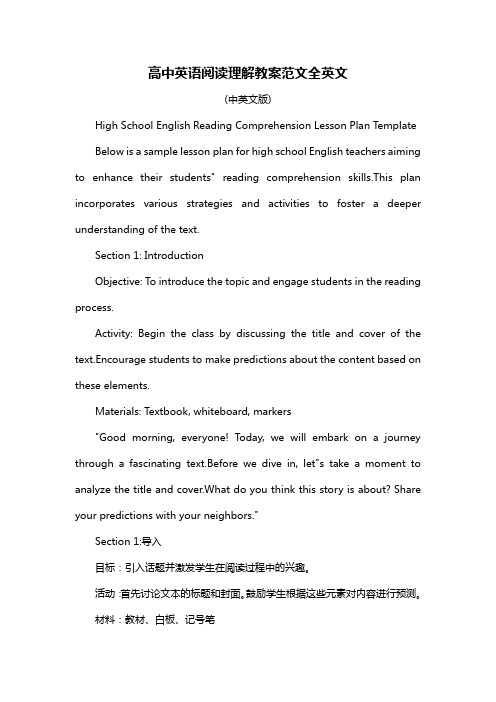
高中英语阅读理解教案范文全英文(中英文版)High School English Reading Comprehension Lesson Plan Template Below is a sample lesson plan for high school English teachers aiming to enhance their students" reading comprehension skills.This plan incorporates various strategies and activities to foster a deeper understanding of the text.Section 1: IntroductionObjective: To introduce the topic and engage students in the reading process.Activity: Begin the class by discussing the title and cover of the text.Encourage students to make predictions about the content based on these elements.Materials: Textbook, whiteboard, markers"Good morning, everyone! Today, we will embark on a journey through a fascinating text.Before we dive in, let"s take a moment to analyze the title and cover.What do you think this story is about? Share your predictions with your neighbors."Section 1:导入目标:引入话题并激发学生在阅读过程中的兴趣。
高中英语全英文教案模板
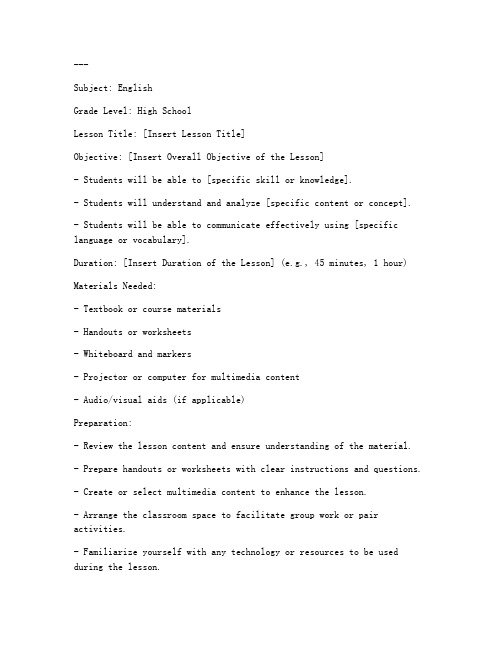
Subject: EnglishGrade Level: High SchoolLesson Title: [Insert Lesson Title]Objective: [Insert Overall Objective of the Lesson]- Students will be able to [specific skill or knowledge].- Students will understand and analyze [specific content or concept].- Students will be able to communicate effectively using [specific language or vocabulary].Duration: [Insert Duration of the Lesson] (e.g., 45 minutes, 1 hour) Materials Needed:- Textbook or course materials- Handouts or worksheets- Whiteboard and markers- Projector or computer for multimedia content- Audio/visual aids (if applicable)Preparation:- Review the lesson content and ensure understanding of the material. - Prepare handouts or worksheets with clear instructions and questions. - Create or select multimedia content to enhance the lesson.- Arrange the classroom space to facilitate group work or pair activities.- Familiarize yourself with any technology or resources to be used during the lesson.Warm-Up (5 minutes)Activity: [Insert Warm-Up Activity]- Purpose: To engage students and activate prior knowledge.- Procedures:1. Begin with a brief discussion or question related to the lesson topic.2. Have students share their thoughts or experiences.3. Transition smoothly into the main part of the lesson.---Introduction (10 minutes)Activity: [Insert Introduction Activity]- Purpose: To introduce the lesson topic and objectives.- Procedures:1. Briefly introduce the topic using a hook (e.g., a question, a video clip, a picture).2. Clearly state the lesson objectives and expectations.3. Provide a brief overview of the lesson structure.---Main Content (25 minutes)Activity 1: [Insert Activity 1]- Purpose: To introduce new vocabulary or concepts.- Procedures:1. Present the new vocabulary or concepts through visual aids, examples, or explanations.2. Have students practice using the new language through interactive activities or exercises.3. Provide feedback and clarification as needed.Activity 2: [Insert Activity 2]- Purpose: To reinforce understanding and application of the new content.- Procedures:1. Conduct a group activity or pair work to apply the new knowledge.2. Provide guidance and support as students work together.3. Encourage students to share their findings or responses.Activity 3: [Insert Activity 3]- Purpose: To deepen understanding and critical thinking.- Procedures:1. Engage students in a discussion or debate related to the lesson topic.2. Use questioning techniques to encourage higher-order thinking.3. Summarize key points and provide additional information if necessary.---Conclusion (5 minutes)Activity: [Insert Conclusion Activity]- Purpose: To review the lesson and reinforce learning.- Procedures:1. Summarize the main points covered in the lesson.2. Ask students to share their learning or reflections.3. Assign homework or provide additional resources for further learning.---Homework Assignment:- [Insert Homework Assignment]- Purpose: To reinforce learning and provide additional practice.---Assessment:- [Insert Assessment Methods]- Purpose: To evaluate student understanding and achievement of the lesson objectives.---Reflection:- [Insert Reflection Questions]- Purpose: To encourage self-assessment and reflection on the lesson.---This template provides a structured outline for creating a high school English lesson plan. Adjust the activities, duration, and materials as needed to fit the specific requirements of your curriculum and student needs.。
高三英语教案(2023)七篇
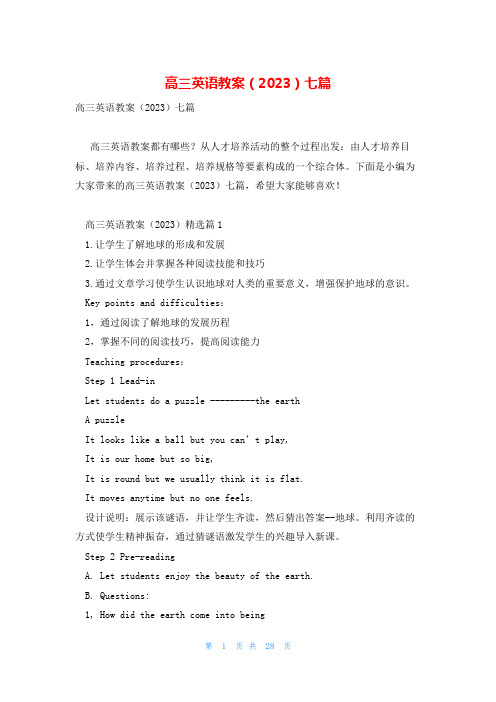
高三英语教案(2023)七篇高三英语教案(2023)七篇高三英语教案都有哪些?从人才培养活动的整个过程出发:由人才培养目标、培养内容、培养过程、培养规格等要素构成的一个综合体。
下面是小编为大家带来的高三英语教案(2023)七篇,希望大家能够喜欢!高三英语教案(2023)精选篇11.让学生了解地球的形成和发展2.让学生体会并掌握各种阅读技能和技巧3.通过文章学习使学生认识地球对人类的重要意义,增强保护地球的意识。
Key points and difficulties:1,通过阅读了解地球的发展历程2,掌握不同的阅读技巧,提高阅读能力Teaching procedures:Step 1 Lead-inLet students do a puzzle ---------the earthA puzzleIt looks like a ball but you can’t play,It is our home but so big,It is round but we usually think it is flat.It moves anytime but no one feels.设计说明:展示该谜语,并让学生齐读,然后猜出答案--地球。
利用齐读的方式使学生精神振奋,通过猜谜语激发学生的兴趣导入新课。
Step 2 Pre-readingA. Let students enjoy the beauty of the earth.B. Questions:1, How did the earth come into being2, In China, there are some stories about the beginning of life. Do you know设计说明:通过图片让学生感受地球,产生热爱地球家园的体验,同时让学生产生了疑问,地球是怎么形成的,顺利过渡到下一部分。
Step 3 Fast-reading1, Let students read the text quickly and then answer the following questions.(1) According to the text, how did the universe begin(2) What is the fundamental to the development of life(3) Where did life first begin, on the land or in the sea(4) Which kind of animal has become the most important animals on the planet today设计说明:设计几个较为简单却有关全局的问题,让学生带着问题快速搜索所需信息,锻炼学生快速阅读的能力。
高三英语全英文教案
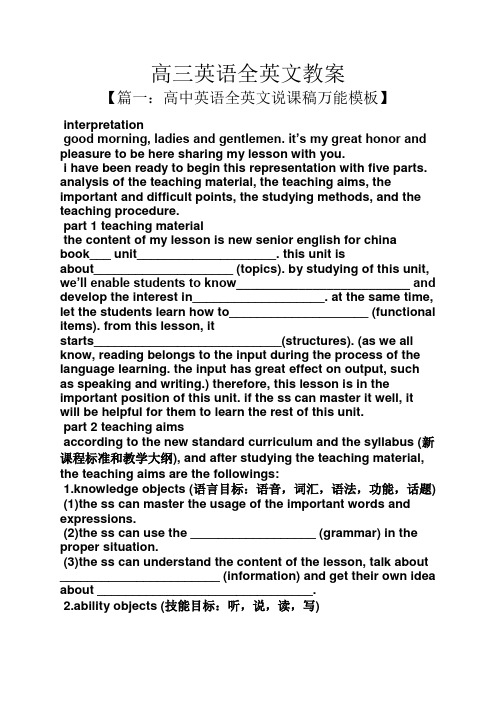
高三英语全英文教案【篇一:高中英语全英文说课稿万能模板】interpretationgood morning, ladies and gentlemen. it’s my great honor and pleasure to be here sharing my lesson with you.i have been ready to begin this representation with five parts. analysis of the teaching material, the teaching aims, the important and difficult points, the studying methods, and the teaching procedure.part 1 teaching materialthe content of my lesson is new senior english for chinabook___ unit____________________. this unit isabout____________________ (topics). by studying of this unit, we’ll enable students to know_________________________ and develop the interest in___________________. at the same time, let the students learn how to____________________ (functional items). from this lesson, itstarts___________________________(structures). (as we all know, reading belongs to the input during the process of the language learning. the input has great effect on output, such as speaking and writing.) therefore, this lesson is in the important position of this unit. if the ss can master it well, itwill be helpful for them to learn the rest of this unit.part 2 teaching aimsaccording to the new standard curriculum and the syllabus (新课程标准和教学大纲), and after studying the teaching material, the teaching aims are the followings:1.knowledge objects (语言目标:语音,词汇,语法,功能,话题) (1)the ss can master the usage of the important words and expressions.(2)the ss can use the __________________ (grammar) in the proper situation.(3)the ss can understand the content of the lesson, talk about _______________________ (information) and get their own idea about _______________________________.2.ability objects (技能目标:听,说,读,写)(1) to develop the ss’ abilities of listening, speaking, reading and writing(2) to guide ss to set up effective studying strategies.(3) to improve the student’s reading ability, especially their skimming and scanning ability.(4) to train the ss’ a bilities of studying by themselves and cooperating.3.emotion or moral objects (情感目标:兴趣,自信,合作,爱国,国际视野)(1)by completing the task, the ss increase their interest in____________________and set up self-confidence in_____________________.(2)teach the ss_________________________, put the moral education in the language study.part 3 the important and difficult pointsbased on the requirement of the syllabus.the important points are__________________________ suchas ______________.the difficult points are_________________________ forexample_____________.part 4 teaching methodsas is known to us all, a good teaching method requires thatthe teacher should help ss develop good sense of the english language. for achieving these teaching aims, (after the analysis of the teaching material and teaching aims,) i will use the following methods according to the modern social communication teaching theories(现代社会交际教学理论) .1. communicative approach(交际教学法)2. whole language teaching(整体语言教学法)3. task-based language teaching (任务教学法)4. total situational action (情景教学)a “scene —activity” teaching method , it establishes a real scene and the interaction between the teacher and the ss. atthe same time, cai (电脑辅助教学) can provide a real situation with its sound and picture, it can develop the ss creativity in learning english.part 5 teaching procedurestep 1 lead-in. (_____min)______________________________________________________ _____________purpose of my design: (1) to catch ss’ attention about the class/topic/passage.(2) to set up suspense/develop interest in _______________. step 2 pre-readingtask 1 (individual work, pair work, group work, class work;_____min)let ss______________________________________________________ _______task 2 (individual work, pair work, group work, class work;_____min)______________________________________________________ _____________now, let’s see what happened to the_______________/ let’s check whether it is right or not.purpose of my design: (1) to get to know something about the _________________.(2) to have a better understanding about the importance of___________________.step 3 while-readingtask 1 (individual work, pair work, group work, class work;_____min)skimming: ss should read the material fast to find out the main idea/topic sentence for each paragraph.para 1 ___________________para 2 ___________________para 3 ___________________task 2(individual work, pair work, group work, class work;_____min)scanning: listen to the tape part by part to finish___________________________.task 3 (individual work, pair work, group work, class work;_____min)scanning: guide ss to read the material carefully and take some important notes, then answer the following questions.task 4 (individual work, pair work, group work, class work;_____min)scanning: ask ss to read the material carefully and find out the correct answers to finish the following chart.purpose of my design:enable students to understand the given material better by using different reading skills. and proper competition can arouse the ss’ interest in english learning. ―task-based‖ teaching method is used here to develop the ss’ ability of communication and also their ability of co-operation will be well trained.step 4 post-readingtask 1 (individual work, pair work, group work, class work;_____min)(接task3)ask ss to close books and finish the summary according their notes.(接task4)retell the story /sum up the passage in ss’ own words according to the chart.task 2 (individual work, pair work, group work, class work;_____min)discuss_______________________________________________with other group members and then choose a reporter to share their opinions about ____________________________________ with the whole class.purpose of my design:i think if the ss can finish this task well, they will benefit a lot in their spoken english. most ss can take their parts in theactivities, especially for the ss who have trouble in english study.step 5 homework1. __________________________________________________2. __________________________________________________ purpose of my design:homework is so important and necessary for to master the knowledge they learned after class. it will check whether the ss achieve the teaching aims.说课二i teaching aims:1. to develop ss’ basic skills of listening, speaking, reading and writing. reading is the focus in this lesson. reading skills for ss include (predicting, skimming, scanning and digesting.)2. to encourage ss to practice, participate, and co-operate in the classroom activities.3. to get ss to know something about … and have a better understanding of the importance of …. as for teaching approaches, i think … ii teaching approaches communicative approach and computer-assisted instruction are to be used in the course of this lesson. and i will try my best to limit ttt, that is, limit teacher talking time and increase stt (student talking time).so during this lesson, emphases are to be laid on:1. student-centered teaching2. task-based learning3. activity-based teaching (individual work; pair work; group work; class work)iii teaching aids:1. a projector2. a multi-media computer systemthey are for showing ss some pictures, some audio files, some visual files, some topics or reading tasks.iv teaching procedurestep 1 warming-up lead-in activity 1 free talks (class work)q1: who do you think looks coolest in our class? q2: do you like him/her? q3: if so, why? if not, why? … download some pictures/music from the internet. guiding qs may be:q1: who’s she/he? q2: do you like him/her? q3: if so, why? if not, why?q4: do you think he/she is perfect? goal: to lead up to the topic, get ss to warm up and arouse their interest in the topic. activity 2 picture-talking /music-talking (individual work) step 2 pre-reading activity1 look and guess (class work) in this activity,ss are required to look at the title/subtitle and guess what they will read.the picture/… activity2 brain-storming (class work)goal: to develop ss’ reading skill---predicting and present some new words in the passage such as …activity 1 skimming (class work) step 3 readingpara of the article (or the first sentence or the last sentence of each para.) goal: to develop ss’ reading skill --- skimming, that is, how can we get the general idea of a passage as quickly as possible. activity 2 scanning (group work)titlepart/para.main ideadetailed information1 a. topic sentences/introductionb. examples/supporting ideasc. conclusiongoal: to develop ss’ reading skill---scanning, that is, how to find out the clue of a story and motivate ss to cooperate with each other. activity 3 report (class work) invite some group members to report their work to the whole class. goal: to overcome ss’ shyness and stimulate ss to speak in public. activity 4 further understanding and word study (pair work) encourage ss to discuss the following qs in pairs (a powerpoint will be used here to present some blank-filling exercises and q1: what does the word ―this‖ in the last para? but 3 refer to?a.b. c. a. b. d. d. q2: what is the chinese equivalent for the phrase ―investing in loss‖? c. q3: theword ―flawless‖ in line 5 of para.2 can be replaced by ___ q4: which of the following statements is true or not true? goal: to help ss to guess the meaning of certain unknown words and understand the passage exactly. multiple choices.)step 4 post-readingactivity1 role-play (pa ir work) suppose one student is a … and the other …. ss are encouraged to put themselves in the situation and make a face-to-face interview. activity2 discussion (group work)topics may be: q1: do u want to be perfect?q2: do u think there is anyone in the world that is perfect? ―remind you‖, remind yourself of what?activity3 poster-designing/cartoon-designing/… (group work) goal: these post-reading activities are intended to develop ss’ creative thinking and get them to know the importance of … task 1 write a summary of the passage (about 100 words) (individual work) goal: to spur ss to consolidate what they have learned. task 2 look up some more information about … (individual work) encourage ss to go to the school library or get on the internet if possible to consult related english websites on the topic. goal: to encourage ss to study english spontaneously and independently after class, arouse ss’ interest in traditional chinese culture and develop ss’ culture awareness and cross-culture communicative skills. as for myblackboard-design, since time is limited, i’d like to give a brief introduction. step 5 homework这是考取教师资格证的第二环节:说课。
高中英语教案英文版5篇

高中英语教案英文版5篇高中英语教案英文版5篇教案可以恰当地选择和运用教学方法,调动学生学习的积极性,面向大多数学生,同时注意培养优秀生和提高后进生,使全体学生都得到发展。
以下是带来的内容,感谢您的阅读,希望能帮助到您!高中英语教案英文版1Teaching Procedures of Period 1:Step1.Warming up (15 mins)Ss know a lot about sports from everyday life and media, so I arrange sucha task -discussion(group of 4): Q: What do you know about sports?During this process, if Ss can’t express themselves in English, Chinese isalso all right. Besides, it is agood chance to present new words. If necessary, I will make somecomplements. At the same time, I will present them as many pictures about sportsas possible.Possible response:school sports meetSports meet the National Gamesthe Asian Gamesthe Olympic Gamesthe World Cupetcball games: volleyball, basket ball, football, table tennis, tennis,,golfbadminton, bowling, baseball, American football, ice hockey etcEvents of sports track and field: relay race, long jump, high jump, polejump, discus, shot, javelin etcgymnastic: rings, double bars, high and low bars, horse , free exerciseswimming/shooting/skiing/ ice sports/diving/aquatic sports etcSport stars : Beckham, Mike Owen, Michael Jordan etc Purpose: This activity is designed to encourage students to think aboutsports and activaterelevant vocabulary.Step 2. Speaking(15 mins)Task1(pair work): Talk about their favourite sports, favourite sportsstars, and the reason why they like them, with the following expressions as aguide.(See SB p52) Task2(pair work): A survey about physical fitness (Seepostscript 1)Task3(group work): Add up their total scores and divide by the number ofpeople. Then get their group’s average scores. Discuss their survey answers.1). Do you think your group is doing well or not? Why ?2). How can you become fitter?高中英语教案英文版2教学目标Teaching aims and demands本单元的教学目标是使学生掌握表示判断和个人看法的常用语句,学会使用现在完成时的被动语态。
高三英语作文教案全英文
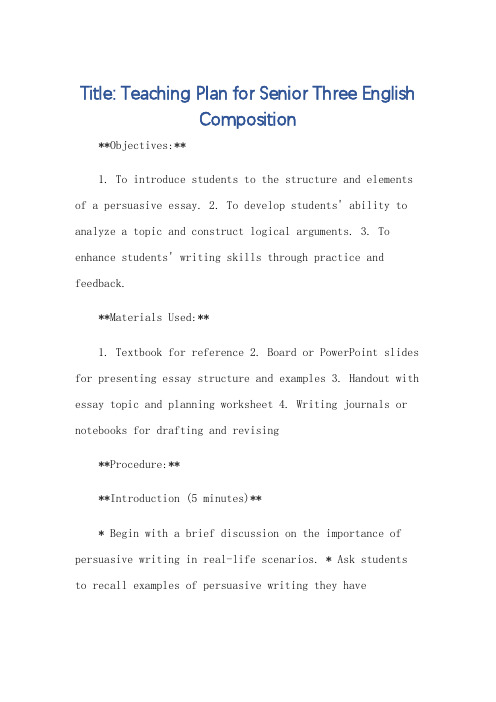
Title: Teaching Plan for Senior Three EnglishComposition**Objectives:**1. To introduce students to the structure and elements of a persuasive essay.2. To develop students' ability to analyze a topic and construct logical arguments.3. To enhance students' writing skills through practice and feedback.**Materials Used:**1. Textbook for reference2. Board or PowerPoint slides for presenting essay structure and examples3. Handout with essay topic and planning worksheet4. Writing journals or notebooks for drafting and revising**Procedure:****Introduction (5 minutes)*** Begin with a brief discussion on the importance of persuasive writing in real-life scenarios. * Ask students to recall examples of persuasive writing they haveencountered (e.g., advertisements, editorials, political speeches).**Presentation (10 minutes)*** Explain the structure of a persuasive essay: introduction, body paragraphs, and conclusion. * Show examples of strong introductions and conclusions, highlighting the use of hooks, background information, and the restatement of the main argument. * Discuss different techniques for building arguments, such as using facts, quotes, and anecdotes.**Planning (10 minutes)*** Distribute the handout with the essay topic and planning worksheet. * Guide students through the planning process, helping them to identify their stand on the topic, gather evidence, and organize their ideas into an outline. **Drafting (15 minutes)*** Ask students to begin writing their essays, focusing on the introduction and the first body paragraph. * Encourage them to use the planning worksheet as a reference and to pay attention to the flow of their arguments.**Feedback and Revision (10 minutes)*** Have students swap their essays with a partner and provide feedback on the clarity of the introduction, the logic of the arguments, and the use of transitional words. * Discuss the feedback as a class, emphasizing common mistakes and ways to improve.**Conclusion (5 minutes)*** Remind students of the importance of revision and the role of feedback in improving their writing. * Encourage them to continue working on their essays at home, focusing on the remaining body paragraphs and the conclusion.**Homework:*** Ask students to complete their essays and submit them for grading. * Provide a rubric or checklist for self-assessment and revision.**Reflection:*** After grading the essays, identify common areas of improvement and prepare to discuss these in the next class. * Consider variations in student ability and provide additional support or challenges as needed.**中文内容:****高三英语作文教案****教学目标:**1. 向学生介绍议论文的结构和要素。
高考英语课程教案七篇
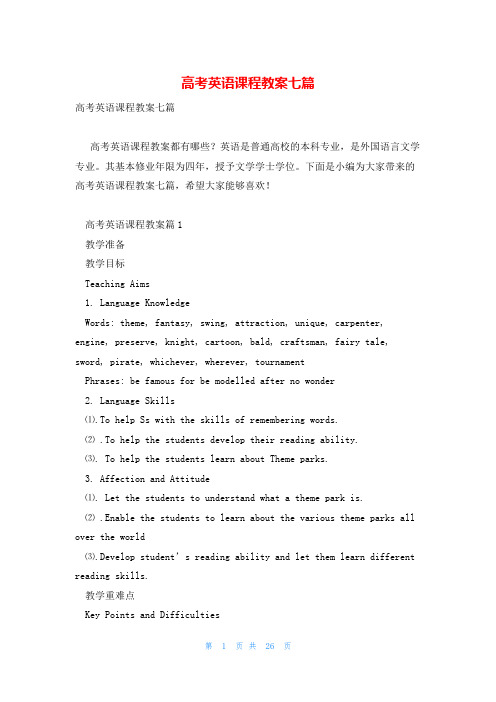
高考英语课程教案七篇高考英语课程教案七篇高考英语课程教案都有哪些?英语是普通高校的本科专业,是外国语言文学专业。
其基本修业年限为四年,授予文学学士学位。
下面是小编为大家带来的高考英语课程教案七篇,希望大家能够喜欢!高考英语课程教案篇1教学准备教学目标Teaching Aims1. Language KnowledgeWords: theme, fantasy, swing, attraction, unique, carpenter, engine, preserve, knight, cartoon, bald, craftsman, fairy tale, sword, pirate, whichever, wherever, tournamentPhrases: be famous for be modelled after no wonder2. Language Skills⑴.T o help Ss with the skills of remembering words.⑵ .To help the students develop their reading ability.⑶. To help the students learn about Theme parks.3. Affection and Attitude⑴. Let the students to understand what a theme park is.⑵ .Enab le the students to learn about the various theme parks all over the world⑶.Develop student’s reading ability and let them learn different reading skills.教学重难点Key Points and Difficulties1. The main idea of each paragraph and a summary of the text.2. How to help the students develop their reading ability.教学过程Teaching ProceduresStep Ⅰ: GreetingsStep Ⅱ: Warming up by discussing1. Discussion (Cooperative discussion)Q1: Have you ever been to a parkQ2: What is a park What is a park forQ3: Can you describe them What about the old onesQ4: Have you ever been to a theme parkQ5: What do you think a theme park isQ6: Do you know the differences between a theme park and a common park(Then ask the students to look at the pictures on the screen and lead them to the topic of this module.)2. Vocabulary study(1). Learn the new words on page99 and give Ss some explanation of the difficult words.(2). Read the new words by themselves, and then ask the students to do some exercises about the new words.StepⅢ: SkimmingRead the passage to get a general idea and the topic sentence of each paragraph.The main idea of the passage: _______________________________.Paragraph1. ______________________________________________.Paragraph2. ______________________________________________.Paragraph3. _____________________________________________.Paragraph4. _____________________________________________.Do these multiple choice exercisesAccording to the text, tourists can find Snow White and Mickey Mouse in ( )A. World WaterparkB. DisneylandC. Central ParkD. Camelot Park2. What’s the Dollywood’s main attraction ( )A. Its cultureB. Its country musicC. Its candy shopsD. Its wooden roller coastersIt can be inferred from the third paragraph that the main purpose of Dollywood is to ( )A. entertainB. make profitsC. show cartoonsD. educate people4. If you want to see fighting with swords or on horseback, which park would you go( )A. DollywoodB. DisneylandC. Camelot ParkD. World WaterparkStepⅣ Careful reading:Read the text carefully and complete the table:Step ⅤRead the passage quickly to tell the following statements true or false.1. Disneyland can be found everywhere. ( )2. You can meet any cartoon character you like at Disneyland. ( )3. Tourism develops where a Disneyland is built. ( )4. Dollywood is in the mountains in the southeastern USA. ( )5. Country music singers perform in Dollywood throughout the whole year. ( )6. Dollywood has the only electric train still working in the USA. ( )7. Visitors to Camelot Park can taste candy like the candy made in ancient England.8. Camelot Park has the oldest roller coaster in the world. ( )9. Camelot Park has an ancient English farm. ( )10. Camelot Park has places for visitors to watch and maybe take part in sword fighting. ( )StepⅥ: group work (design)1. What is the name of your theme park2. What is the theme3. Any attractions4. What do you want to show visitors and teach visitors课后习题1. Please recitesome useful words and phrases and try to use them to make sentences.2. Read thepassage after class.板书Blackboard designUnit 5 Theme parksPhrases: be famous for be modeled after no wonder高考英语课程教案篇2教学目标Teaching goals 教学目标Target language目标语言a重点词汇和短语astronomy, atmosphere, system, violent, solid, explode, carbon, dioxide, oxygen, surface, planet, harmful, development, spread, method, depend, solar system, in time, prevent…from, depend onb重点句子1.What it was to become was a mystery until the dust began to slowly combine into a ball moving around the sun. P252.It’s exploded loudly with fire and rock, which were in time to produce the water vapour, carbon dioxide, oxygen, nitrogen and other gases, which were to make the earth’s atmosphere. P253.It allowed the earth to dissolve harmful gases, which had become part of the earth’s atmosphere, in to the oceans and seas. P254.Whether life will continue on the earth for millions of years to come will depend on whether this problem can be solved. P26Ability goals 能力目标a. Enable Ss to talk about the science of the stars, the development of life and space travel and gravityWhere do we come fromHow did the universe beginWhy is the universe the way it wasHow will it endHow much do you know about universeDo you want to have a space travelDo you know something about gravityb. Understand the text and answer the following questions:1. What was there on the earth before life could begin2. Why do scientists think there has never been life on the moon3. Why did animals first appear in the seas4. Why did green plants help life to develop5. Why were mammals different from other animalsc. Enable the Ss to understand the details about the passage, choosing the correct answer according to the text and put the order of development of life into a time line and answer questions.d. Retell the passage using key sentences.Learning ability goals 学能目标Enable Ss learn how to talk about the beginning of life on the earth.教学重难点Teaching important points教学重点a. Talk about the beginning of life on the earth.Why did animals first appear in the seasWhy did green plants help life to developb. Discuss the order of development of lifeTeaching difficult points教学难点a. Understand the beginning of life on the earth.b. Discuss the questions:What will our future be if the earth may become too hot for the lives on itWhy are humans the cleverest animals on the earth高考英语课程教案篇3Disneyland教学目标本单元对话课复习了有关问路及应答用语,要求学生用所学语言自编对话描述所在学校、区域或城市;本单元介绍了美国的迪斯尼乐园及其创始人Walt Disney艰苦创业的生活经历。
高三英语教案范例五篇
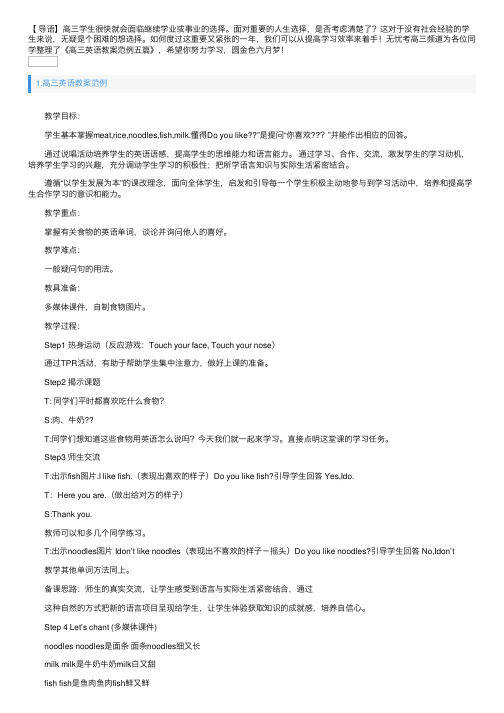
【导语】⾼三学⽣很快就会⾯临继续学业或事业的选择。
⾯对重要的⼈⽣选择,是否考虑清楚了?这对于没有社会经验的学⽣来说,⽆疑是个困难的想选择。
如何度过这重要⼜紧张的⼀年,我们可以从提⾼学习效率来着⼿!⽆忧考⾼三频道为各位同学整理了《⾼三英语教案范例五篇》,希望你努⼒学习,圆⾦⾊六⽉梦!1.⾼三英语教案范例 教学⽬标: 学⽣基本掌握meat,rice,noodles,fish,milk.懂得Do you like??”是提问“你喜欢???”并能作出相应的回答。
通过说唱活动培养学⽣的英语语感,提⾼学⽣的思维能⼒和语⾔能⼒。
通过学习、合作、交流,激发学⽣的学习动机,培养学⽣学习的兴趣,充分调动学⽣学习的积极性;把所学语⾔知识与实际⽣活紧密结合。
遵循“以学⽣发展为本”的课改理念,⾯向全体学⽣,启发和引导每⼀个学⽣积极主动地参与到学习活动中,培养和提⾼学⽣合作学习的意识和能⼒。
教学重点: 掌握有关⾷物的英语单词,谈论并询问他⼈的喜好。
教学难点: ⼀般疑问句的⽤法。
教具准备: 多媒体课件,⾃制⾷物图⽚。
教学过程: Step1 热⾝运动(反应游戏:Touch your face, Touch your nose) 通过TPR活动,有助于帮助学⽣集中注意⼒,做好上课的准备。
Step2 揭⽰课题 T: 同学们平时都喜欢吃什么⾷物? S:⾁、⽜奶?? T:同学们想知道这些⾷物⽤英语怎么说吗?今天我们就⼀起来学习。
直接点明这堂课的学习任务。
Step3 师⽣交流 T:出⽰fish图⽚.I like fish.(表现出喜欢的样⼦)Do you like fish?引导学⽣回答 Yes,Ido. T:Here you are.(做出给对⽅的样⼦) S:Thank you. 教师可以和多⼏个同学练习。
T:出⽰noodles图⽚ Idon’t like noodles(表现出不喜欢的样⼦-摇头)Do you like noodles?引导学⽣回答 No,Idon’t 教学其他单词⽅法同上。
高三英语教案(5篇范文)

高三英语教案(5篇范文)第一篇:高三英语教案You are the best!高三英语教案2014.8.17 复习计划:先基础后综合三步走第一步:基础复习——单词及语法第二步:单项突破第三步:大综合前几堂课主要讲基础,穿插讲一些完型或阅读,后面逐渐向高考题型过渡英语是一门积累的学科,心急吃不了热豆腐推荐辅导教材:维克多英语词汇五年高考三年模拟英语提分保障:每天定量背单词,一天一篇完型和阅读,一周一篇作文,每天早晨听听力一、词汇及词组:Hold住单词,提高词汇量,你就是王者1.abandon2.abnormal3.aboard4.abolish5.abrupt6.absolute7.absorb8.abstract 9.absurd 10.abundant 11.abuse 12.academic 13.accelerate 14.acceptable 15.access16.accessible17.accident18.accommodation 19.accompany20.accomplishYou are the best!21.account22.accountant 23.accuracy 24.accurate 25.accuse26.accustomed 27.achievement 28.acknowledge29.acquisition 30.adapt作业:背好这30个单词二、语法:基础扎实,步步为营倒装句:全倒装:主谓倒,句首无助动词部分倒装:助动词提前,其他语序不变;若原句中无助动词,则需根据时态在句首添加do does等一、全倒装:1、当here, there, out, in, up, down等副词放在句首时, 句子需全倒装: e.g.注意:1)2)2、方位状语在句首e.g.3、句子主语较长,谓语较短,为了强调主语,可全倒装 e.g.二、半倒装1、否定意义的词在句首, 句子半倒装, 例如: little, never, not, no, hardly, rarely,seldom e.g.2、几对并列连词如not only…but also, hardly… when等连接两个并列句, 连词在句首, 前句半倒装, 后句不倒装:You are the best!e.g.3、only在句首强调状语, 主句半倒装: e.g.注意: only强调主语不倒装:Only the teachers can use the room.4、so…that句型, so在句首时, 主句倒装, that从句不倒装: e.g.5、省略了if的虚拟条件句:(句中必须有were,had等助动词)e.g.三、as引导的让步状语从句(as在句子中当尽管讲)1、从句谓语部分:不及物动词+副词,可将副词放句首。
高中英语教案设计全英文版
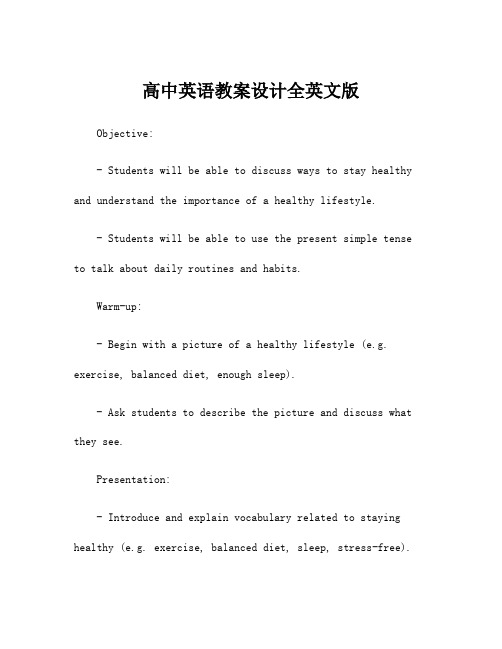
高中英语教案设计全英文版Objective:- Students will be able to discuss ways to stay healthy and understand the importance of a healthy lifestyle.- Students will be able to use the present simple tense to talk about daily routines and habits.Warm-up:- Begin with a picture of a healthy lifestyle (e.g. exercise, balanced diet, enough sleep).- Ask students to describe the picture and discuss what they see.Presentation:- Introduce and explain vocabulary related to staying healthy (e.g. exercise, balanced diet, sleep, stress-free).- Show pictures or short video clips to illustrate each concept.Practice:- Group students into pairs or small groups and have them discuss their daily routines and habits related to staying healthy.- Elicit responses from each group and provide feedback on the use of vocabulary and grammar.Production:- In pairs, students will create a short dialogue about a healthy lifestyle, incorporating the vocabulary and grammar discussed in class.- Randomly select a few pairs to perform their dialogues in front of the class.Conclusion:- Review the key concepts and vocabulary related to staying healthy.- Assign homework to have students write a short paragraph about their own healthy habits and routines.。
高三英语教案内容七篇_1

高三英语教案内容七篇高三英语教案内容最新七篇高三英语教案内容都有哪些?从教学活动的过程动身:由专业设置、课程体系设置、师资队伍建设及教学质量评价体系等构成。
下面是我为大家带来的高三英语教案内容七篇,盼望大家能够喜爱!高三英语教案内容(精选篇6)高三英语教案内容(精选篇7)一、教学目标学问目标1. Get students to learn some useful new words and expressions in this part.2. Get students to read the play.3. Let students learn the expressions of ordering food.力量目标1. Develop students’ reading skills and enable them to learn how to use different reading strategies to read different reading materials.2. Enable students to understand and act out theplay.3. Have students learn how to use the expressions to order food.情感目标1. Stimulate students’interests of learning English by reading and acting this play.2. Develop students’ sense of group cooperation and teamwork.二、教学重点1. Develop students’ reading and speaking skills.2. Let students read and act the play.3. Have students learn to use the expressions to order food.三、教学难点1. Enable students to learn to use reading strategies such as skimming, scanning, and so on.2. Get students to act the play.3. Have students make a dialogue at the restaurant.教学过程→Step 1 Revision1. Check the homework exercises.2. Ask two students to retell the content of ActI, Scene 3.in their own words.→Step 2 Warming upWe have learned that Henry got a letter from the two old brothers ,so please predict what will happen next.→Step 3 Reading1. Read the play fast to understand the gist and decide whether the following statements are true or false.1)The owner looked down upon Henry when he noticed Henry’s appearance.2)Henry asked for more of the same food because he is an American who like to eat a lot.3)When Henry saw the million pound bank note, he was happy and proud of it.4)The owner didn’t believe that the bank note was real and he asked Henry to get out of the restaurant.2. Read the play carefully and do the following: 1)Answer these questions in small groups.(1)Whose behavior changes the most during this scene? Give examples.(2)What kind of person is the owner of therestaurant?(3)Why do you think the owner of the restaurant gave Henry a free meal?2)Pay much attention to the different attitudes towards Henry.Before Henry shows his million pound bank note: Owner Hostess WaiterThat one’s reserved.Well, we will have to take a chance.. . . if you pay the bill. . . My goodness! He eats like a wolf.It’ll cost a tiny bit.Again, everything?What’s there to wait for?After Henry shows his million pound bank note: Owner Hostess WaiterI’m so sorry, sir, so sorry.Oh, please, don’t worry, sir. Doesn’t matter at all.Just having you sit here is a great honor! . . . bow. . . ScreamsAnd you put him in the back of the restaurant!bow. . . bow. . .3. Retell the story:With the envelope in hand, Henry decided to enter a restaurant for a meal. He ordered some ham and eggs and a nice big steak together with a tall glass of beer. The waiter told him the meal would cost him a tiny bit. After eating his first order, Henry asked for more of the same.When Henry opened the letter, he found it was a million pound bank note. He was surprised but the owner and the waiter were shocked. The owner was not sure if it was genuine or fake. They couldn’t believe Henry who was in rags could be so rich. At last, the note was proved to be real.After knowing that the bill is genuine, the owner thanked Henry again and again for his coming to his little eating place and even asked Henry to forget the bill . The owner, hostess and waiter all bowed together as Henry left.→Step 4 Language points1.order n. 要(叫)的菜 eg. May I take your order?n. 挨次,次序 eg. The books are arranged in order of size.n. 命令 eg. Soldiers must obey ordersv. 命令 eg. The officer ordered his soldiers to marchv. 预定,预购 eg. I have ordered a steak.2.take a chance 碰运气Eg. As for whether he will win the game or not ,we must take a chance .Maybe true love is a decision, a decision to take a chance with somebody.或许真爱只是一个打算,一个与某个人一起冒险的打算。
高三学生英语教案最新七篇

高三学生英语教案最新七篇高三学生英语教案(篇1)教学目标:1.知识目标words :when back those ice cream with finish hurry wp wait drop (2个词组2个过去式 came dropped)sentences: When did you come backWe came back last Sunday.I dropped my ice cream.2.能力目标(1)学生能认读并拼写本课单词(2)掌握动词的过去式形式3.情感目标运用过去式描述过去发生的事情教学重点:动词过去式的形式及相关句型教学难点:1.一般现在时一般过去时一般将来时的区别2.含有动词过去式的特殊疑问句的构成教学过程:一、Warm-upT: Hello,boys and girls. How are youS: Im fine thank you.T: Today Lets talk something about summer holiday, OKI have three questions.Number1Where did you goS: I went to...T: Olny yourself And your mother and farther. Yes! So you can say.I went to...with...(设计目的:复习go的过去式went.同时引出with这个单词!What did you buyI bought…。
(设计目的:复习buy的过去式bought.)When did you come back1.用come here学come back帮助学生理解2.I went to Henan in Summer holiday.Now its September.I came back last month.(利用日历学习)用last month帮助理解when,进一步学习3 对比学习come---cameask and answer in pairs(设计目的:不仅学会回答,也掌握问句)summary: 总结过去时go--went do—didcome--came buy—bought二、以ice cream 引出所学内容,(1) T: Boys and girls are very clever,so today I bring some presents. Oh,look ,its an...(板书ice cream并教授,教师拿着卡片问Do you like these ice creams S: Yes.T:look at those ice creams. Theyre nice.(板书those.并对比学习these-those(2)出现bus的图片,边做动作边讲hurry up,通过挥手讲wait for usfinish吃完(找几个学生,发给他们几块小东西,很快能够完成的)1 教师先模仿,吃完手中的东西说:I finished my ..2 对一个学生说Please finish your..这个学生再对下一个学生重复同样的句子3 全班同学一起说"Please finish your.."drop-dropped 通过动作。
高中英语教案模板全英文(共7篇)
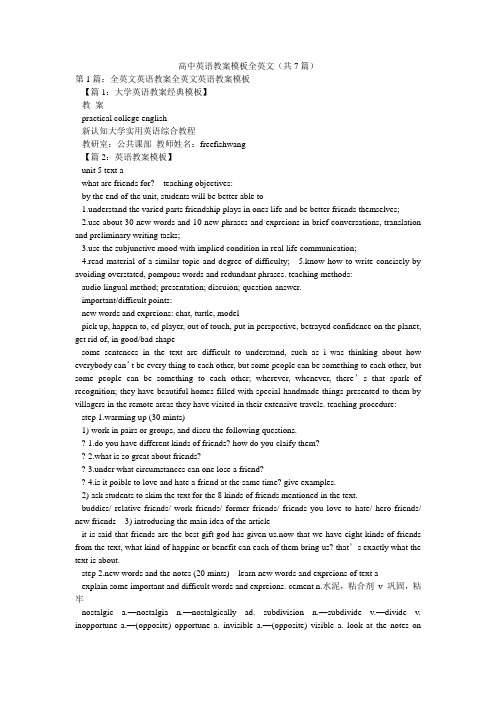
高中英语教案模板全英文(共7篇)第1篇:全英文英语教案全英文英语教案模板【篇1:大学英语教案经典模板】教案practical college english新认知大学实用英语综合教程教研室:公共课部教师姓名:freefishwang【篇2:英语教案模板】unit 5 text awhat are friends for? teaching objectives:by the end of the unit, students will be better able to1.understand the varied parts friendship plays in ones life and be better friends themselves;e about 30 new words and 10 new phrases and expreions in brief conversations, translation and preliminary writing tasks;e the subjunctive mood with implied condition in real life communication;4.read material of a similar topic and degree of difficulty;5.know how to write concisely by avoiding overstated, pompous words and redundant phrases. teaching methods:audio lingual method; presentation; discuion; question-answer.important/difficult points:new words and expreions: chat, turtle, modelpick up, happen to, cd player, out of touch, put in perspective, betrayed confidence on the planet, get rid of, in good/bad shapesome sentences in the text are difficult to understand, such as i was thinking about how everybody can’t be every thing to each other, but some people can be something to each other, but some people can be something to each other; wherever, whenever, there’s that spark of recognition; they have beautiful homes filled with special handmade things presented to them by villagers in the remote areas they have visited in their extensive travels. teaching procedure:step 1.warming up (30 mints)1) work in pairs or groups, and discu the following questions.? 1.do you have different kinds of friends? how do you claify them?? 2.what is so great about friends?? 3.under what circumstances can one lose a friend?? 4.is it poible to love and hate a friend at the same time? give examples.2) ask students to skim the text for the 8 kinds of friends mentioned in the text.buddies/ relative friends/ work friends/ former friends/ friends you love to hate/ hero friends/ new friends 3) introducing the main idea of the articleit is said that friends are the best gift god has given us.now that we have eight kinds of friends from the text, what kind of happine or benefit can each of them bring us? that’s exactly what the text is about.step 2.new words and the notes (20 mints) learn new words and expreions of text aexplain some important and difficult words and expreions. cement n.水泥,粘合剂v 巩固,粘牢nostalgic a.—nostalgia n.—nostalgically ad. subdivision n.—subdivide v.—divide v. inopportune a.—(opposite) opportune a. invisible a.—(opposite) visible a. look at the notes onpage 1161.marion wink: poet, eayist, and regular commentator on national public radio’s.the author made up the capitalized expreions in the text such as “faraway friend,” “relative friend,” which would make no sense at all out of context, with the latter in particular.2.you quit doing drugs, you’re not such good friends with your dealer anymore: this is not meant to be taken seriously.poeion or sale of illegal drugs can result in long prison terms.step 3.key points (60 minutes)? 1.cry on sb.’s shoulder: get sympathy from someone when you tell them your problems 向某人诉苦以寻求抚慰(或同情)e.g.at least she hadn’t cried on his shoulder again.if you ever need a shoulder to cry on, just call me.? 2.in return (for sth.): as payment or reward for something作为回报或回报e.g.he is always helping people without expecting anything in return.we offer an excellent all-round(全面的,多角度的)education to our students.in return, we expect students to work hard. ? 3.they hold out through innumerable crises before...: they are alwaysreliable(可靠的,可信信赖的)and nice when you are in difficult times even though they don’t like what you are doing... ? 4.while so many family relationships are tinged with guilt and obligation:while so many people may feel something of a sense of guilt orresponsibility in dealing with family relationships...? pany goip, once an infallible(绝对可靠的)source ofentertainment, soon awkwardly accentuates the distance between you: office chat used to be an effective way of amusement for you; however, it makes you feel uneasy since you do not work together anymore and therefore increases the feeling of distance between you.? 6.work friends share certain memories which acquire a nostalgic glowafter about a decade:memories of your work friends makes you happy after ten years, so yousomehow wish that you could return to those days.? 7.dead end: a street with no way out at one end or a situation from which nomore progre in poiblee.g.he realized that the job at which he had been aiming all these yearsseemed to him to be a dead end. he thinks they have reached an evolutionary(逐渐发展的,演变的)dead end.? 8.when you feel you’ve hit a dead end, come to a confusing fork in theroad, or gotten lost in some cracker-box subdivision of your life:whenever you feel helple, confused or at a lo(困惑的,手足无措的)in the complicated journey of your life...notice that “cracker-box division” is not a general expreion, but is rather made up by the author.cracker: 薄脆饼干;咸饼干sth.: formal owning or having obtained something from somewhere 占有(或拥有)某物e.g.she was found in poeion of stolen goods.how did the painting come into your poeion (=how did you get it) ? ? 10.to death: informal used to emphasize that a feeling or emotion is very strong? be bored / scared / frightened etc.to deathshe was scared to death of what might happen next.i’m absolutely sick to death of it (=very angry, bored, or unhappy about something) .? bore / scare / love etc.somebody to deathhe drove at a speed which frightened leonora to death.she used to worry me to death.? 11.make me/you sick: spoken a) make you feel very angrye.g.people like you make me sick!b) indicate a feeling of jealousy — used humorouslye.g.you make me sick with your “expenses paid” holidays!? 12.wherever, whenever, there’s that spark of recognition(认识):when you meet a “new friend” for the first time you instantly feel a connection with each other. step 4.aignment (5 minutes)1.read the article repeatedly and try to remember the new words and expreions in text a2.finish the study and practice on page 118-130.the teaching plan of unit 5 what are friends for?(college english 2) english department sun xiaofang【篇3:全英文英语阅读课教案模板】阅读课教案school__ number3 middle school____junior or senior section _junior__ cla ____3____ grade _1_______size ______45__ time_40_______date __2009-12-28____ materials __go for it______type of leon _reading ____ contents: 1.vocabulary: some nouns about furniture and some daily use things: table, bed, dreer, bookcase, sofa, chair, backpack, books, keys, baseball, drawer, plant. some prepositions of place: on, in, under2.structure: where is (where’s)…?it is (it’s) in/on/under…where are…?they are (they’re) in/on/under… where’s/where’re…?i don’t know.is it /are they on/in/under… ?no, it isn’t./they aren’t./ yes, it is./they are.3.1) dialogue: where’s the bag?i don’t know.is it on the dreer?no, it isn’t.where are my books?i don’t know.are they on the bed?no, they’re not.2)writing: ask, gue and write objectives:1.instructional objectives (language knowledge and language skills)1) to promote students’vocabulary development (table, bed, dreer,bookcase, sofa, chair, backpack, books, keys, baseball, drawer, plant.…)2) to promote students’reading skills a) prediction b) skimming3) to promote students’oral english4) to develop students’writing skill cational objectives (affect, learning strategy and cultural awarene)1) to develop students’ability to communicate with others to get information2) to build students’confidence3) to make students learn to cooperate with others 3.personal objectives:1) to develop teacher’s ability of claroom management focal points: a: the nouns. b: prepositions of place c: where- question andd: answers to “is the… in/on/under the …?”;difficult points: a: use the prepositions to describe position of thingsb: use the where-question and is it-/are they -question to ask things’positionaids: ppt, blackboard, chalk … pr ocedures and time allotment1.getting students ready for learning( mins) 1) greetings: good morning everyone! 2) routine task: duty report2.revision: use some pictures to review the vocabulary ( table, bed, dreer, bookcase, sofa, chair, backpack, books, keys, baseball, drawer, plant, on, in, under) and sentence structure:where is (where’s)…?it is (it’s) in/on/underwhere are…?they are (they’re) in/on/under… 3.pre-reading :step1: vocabulary and some phrases learningtask: look at the conversation between them and gue the meaning of the sentences in red.( using the conversation between liu qian and a xin to show those phrases to the students in order to learn them by the context; because the sentence structure in the conversation is those they have learnt) (… mins)此步骤包含词汇、语法教学等 4.while-reading 5.post-reading(… mins)1) oral work 2) written work 6.aigning homework1) conclusion: a: vocabularyb: sentence patterns: where is (where’s)…?it is (it’s) in/on/under…where are…?they are (they’re) in/on/under…where’s/where’re…?i don’t know.is it /are they on/in/under… ?no, it isn’t./they aren’t./ yes, it is./they are. 2) homework: ask, gue and writelet your partner to ask as well as gue where your things are in your room.write down your conversation by using the following sentence patterns:a: where’s/where’re your…? b: you can gue.a: i don’t know.is it /are they on/in/under… ?b: no, it isn’t./they aren’t.yes, it is./they are.…self-evaluation第2篇:全英文幼儿园英语教案全英文幼儿园英语教案【篇1:幼儿园英语教案】幼儿园英语教案-好吃的水果一、活动内容:《好吃的水果》二、活动目的:1、在游戏中学习英语单词,如:apple、banana、orange、pear、grape、peach等等。
高三英语作文教案全英文

高三英语作文教案全英文Hey everyone! Today I'm going to tell you about an English composition teaching plan for senior three.First, we need to learn a lot of new words and phrases. That's like building blocks for our writing. We can play games to remember them easily.Then, we'll read some really good English compositions. They're like examples that show us how to write well. We can learn from them and get some great ideas.After that, we'll practice writing. We'll start with short paragraphs and then work our way up to longer ones. It'll be like building a tower, one brick at a time.We'll also have group discussions. We can share our ideas and help each other make our writing better. It'll be like a team working together.And our teacher will give us lots of feedback. They'll tell us what's good and what we need to improve. It's like getting a guide to help us on our writing journey.I think this teaching plan will be really fun and helpful. We'll learn how to write amazing English compositions and be ready for any challenges. Let's go for it!。
高中英语全英教案设计模板
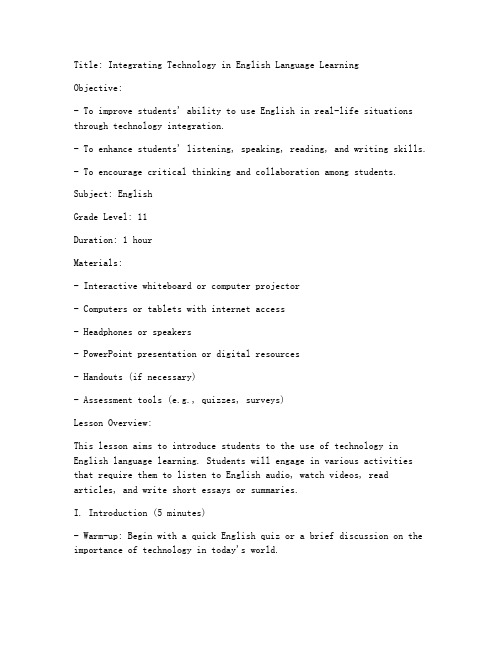
Title: Integrating Technology in English Language LearningObjective:- To improve students' ability to use English in real-life situations through technology integration.- To enhance students' listening, speaking, reading, and writing skills.- To encourage critical thinking and collaboration among students.Subject: EnglishGrade Level: 11Duration: 1 hourMaterials:- Interactive whiteboard or computer projector- Computers or tablets with internet access- Headphones or speakers- PowerPoint presentation or digital resources- Handouts (if necessary)- Assessment tools (e.g., quizzes, surveys)Lesson Overview:This lesson aims to introduce students to the use of technology in English language learning. Students will engage in various activities that require them to listen to English audio, watch videos, read articles, and write short essays or summaries.I. Introduction (5 minutes)- Warm-up: Begin with a quick English quiz or a brief discussion on the importance of technology in today's world.- Introduction: Explain the lesson objectives and how technology will be used to achieve them.II. Listening and Speaking (10 minutes)- Activity: Play a short English podcast or a YouTube video related to the topic of the lesson.- Task: Ask students to summarize the main points of the audio/video in their own words.- Group Work: Divide students into small groups and have them discuss their summaries.- Presentations: Each group presents their summary to the class.III. Reading and Writing (15 minutes)- Activity: Provide students with an article or a series of web pages related to the topic.- Task: Students read the material and answer comprehension questions.- Writing: Ask students to write a short essay or summary based on the reading material.IV. Collaboration and Critical Thinking (10 minutes)- Activity: Assign a project that requires students to use technology to research a topic and present their findings.- Task: Students work in pairs or small groups to complete the project.- Group Work: Each group shares their research and presentation with the class.V. Reflection and Assessment (10 minutes)- Reflection: Have students reflect on what they have learned about using technology in English language learning.- Assessment: Provide feedback on the essays or summaries written during the lesson. Use quizzes or surveys to assess students' understanding of the material.Conclusion:- Summary: Recap the main points of the lesson and reinforce the importance of technology in English language learning.- Homework: Assign a related task that involves using technology, such as watching a YouTube video or reading an article in English.Assessment Criteria:- Listening and Speaking: Ability to summarize audio/video content accurately and express thoughts clearly.- Reading and Writing: Understanding of the material, accuracy of the summary or essay, and use of appropriate vocabulary and grammar.- Collaboration and Critical Thinking: Ability to work effectively in a group, critical analysis of the topic, and creativity in the project.Note: This template can be adapted to different topics and lesson objectives. Ensure that the activities are engaging and relevant to the students' interests and learning styles.。
高考英语教学教案范文七篇大全

高考英语教学教案范文七篇大全高考英语教学教案范文(精选篇1)Listening and SpeakingTeaching Aims: 教学目的1. Review the words and structures in the last period.2. Finish the listening exercises in this part and improve the students’ listening ability.3. Talk about sailing.Teaching Important Points:教学难点Finish the listening exercises.Teaching Methods:教学方法1. Talking method to improve the students’ speaking ability.2. Listening method to train the students’ listening ability.3. Pair wok to make every student take an active part in class.Teaching Aids:教学工具1. a computer;2. coursewareTeaching proceduresStep1 GreetingsGreet the whole class as usual.Step2 RevisionCheck the homework exercises.Step3 ListeningListen to the tape and ask the students to finish exercise 1—3 on page 19.Suggested answers:Answer key for Exercise 1:maps; stars; clouds; waves; currents; birdsAnswer key for Exercise 2;Sailors fromSea or OceanSkillsPhoeniciaMediterra?neanUsed the sky to find their way高考英语教学教案范文(精选篇2)A Christmas CarolI. Teaching aims:1. Learn about Charles Dickens and his works.2. Talk about social responsibilities.3. Review the Adverbial.4. Write a review of a play.II. Teaching time:1st Period Speaking2nd Period Reading3rd Period Language study4th Period Extensive reading, WritingThe First Period SpeakingI. Teaching goals:1. Enable the students to say something about Charles Dickens and his works.2. Enable the students to learn how to discuss their social responsibilities.3. Help the students learn to describe social responsibilities by using some key words and expressions.II. Teaching important points1. Describe Charles Dickens and his works.2. Discuss the social responsibilities by using some key words and expressions.III. Teaching methodsCooperative learning.IV. Teaching aids1. A recorder;2. A projector and some slides;3. Multi-functional teaching equipment (CAI).V. Teaching procedures waysStep I Lead InFirst show the students a picture of Charles Dickens on the computer, then ask them some questions.Step II Warming upThe Warming-up exercise makes the students know more about Charles Dickens and the novels that he wrote.Step III SpeakingTask 1Ask the students to finish the reading comprehension multiple choices.Task 2Discuss the responsibilities of business people towards both their employees and their customers .Step IV TalkingAsk the students to discuss the two situations in groups of four.Step V HomeworkAsk the students to read the novel A Christmas Carol carefully. Then next class they will be checked.高考英语教学教案范文(精选篇3)1 occupation【课文原句】occupation工作/ 职业他的职业是什么?What is his occupation?辨析:occupation, job, work和profession 这四个名词都有“工作”之意。
高中英语教案英文4篇
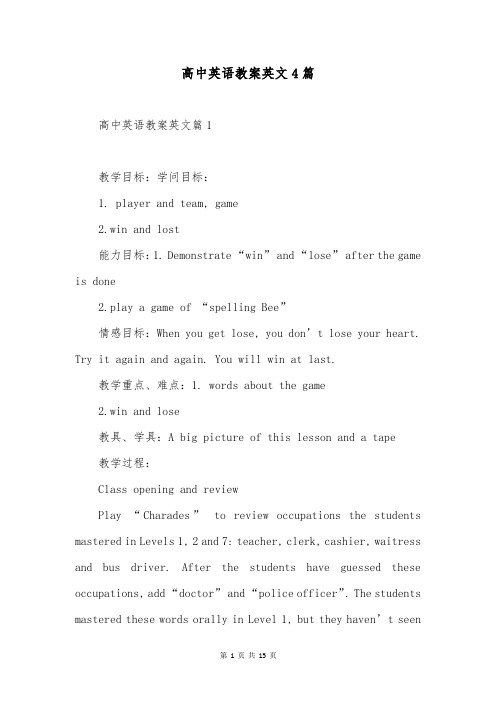
高中英语教案英文4篇高中英语教案英文篇1教学目标:学问目标:1. player and team, game2.win and lost能力目标:1. Demonstrate “win” and “lose” after the game is done2.play a game of “spelling Bee”情感目标:When you get lose, you don’t lose your heart. Try it again and again. You will win at last.教学重点、难点:1. words about the game2.win and lose教具、学具:A big picture of this lesson and a tape教学过程:Class opening and reviewPlay “Charades”to review occupations the students mastered in Levels 1, 2 and 7: teacher, clerk, cashier, waitress and bus driver. After the students have guessed these occupations, add “doctor” and “police officer”. The students mastered these words orally in Level 1, but they haven’t seenthem for a long time. Whisper the translation for these occupations to the students acting them out, and help the class guess the occupations with lots of prompts and encouragement. You can, for example, draw blanks on the blackboard and slowly write in the letters as you soundout more and more of each occupation.IntroduceDemonstrate “player”“team”“game” with six volunteers and a game of “spelling bee” divide the volunteers into two teams of three. Give player a sheet of coloured paper to hold, the same colour for each team.Demonstrate “win” and “lose” after the game is done. Point to the teams and as you say “You win/lose”Use the student bookPause after Number 1 in the student book.Review the story so far. Li Ming and Jenny have been learning about sports. Look at the pictures in the student book. What are they doing now?Note some of the idiom in this lesson: Bob plays basketball “for fun” Jenny and Li Ming “jump up and down” Li Ming asks Jenny “What’s the score?” What do the students think these phrases mean?PracticeDivide the class into small groups. In each group. Some students pretend that they want to learn a game that the other students know how to learn a game that you play in class.Do the activity bookClass closing高中英语教案英文篇2教学目标学问与技能(1)熟练把握下列词汇:rules, arrive, late, hall, dinning hall, listen, , fight, sorry outside,wear, important, bring, uniform, quiet(2)熟练把握下列短语:dining hall, arrive late for school, (be) on time, listen to music break the rules, in class, be/ keep quiet, a lot of, bring …to…,wear a hat, have to, music players(3)把握下列句型:1. Dont eat in class.2. You must be on time.3. Eat in the dining hall.4. 正确使用情态动词can, can’t——Can we wear a hat in school?——Yes, we can./No, we can’t.5. 能正确使用have to 和 must 谈论规章制度We must be on time/ We also have to be quiet in the library.教学重难点重点:1) 确定祈使句是省略掉主语的原形动词开头;2) 否定祈使句则是在确定祈使句前加上“don’t”。
- 1、下载文档前请自行甄别文档内容的完整性,平台不提供额外的编辑、内容补充、找答案等附加服务。
- 2、"仅部分预览"的文档,不可在线预览部分如存在完整性等问题,可反馈申请退款(可完整预览的文档不适用该条件!)。
- 3、如文档侵犯您的权益,请联系客服反馈,我们会尽快为您处理(人工客服工作时间:9:00-18:30)。
高三英语全英文教案【篇一:高中英语全英文说课稿万能模板】interpretationgood morning, ladies and gentlemen. it’s my great honor and pleasure to be here sharing my lesson with you.i have been ready to begin this representation with five parts. analysis of the teaching material, the teaching aims, the important and difficult points, the studying methods, and the teaching procedure.part 1 teaching materialthe content of my lesson is new senior english for chinabook___ unit____________________. this unit isabout____________________ (topics). by studying of this unit, we’ll enable students to know_________________________ and develop the interest in___________________. at the same time, let the students learn how to____________________ (functional items). from this lesson, itstarts___________________________(structures). (as we all know, reading belongs to the input during the process of the language learning. the input has great effect on output, such as speaking and writing.) therefore, this lesson is in the important position of this unit. if the ss can master it well, itwill be helpful for them to learn the rest of this unit.part 2 teaching aimsaccording to the new standard curriculum and the syllabus (新课程标准和教学大纲), and after studying the teaching material, the teaching aims are the followings:1.knowledge objects (语言目标:语音,词汇,语法,功能,话题) (1)the ss can master the usage of the important words and expressions.(2)the ss can use the __________________ (grammar) in the proper situation.(3)the ss can understand the content of the lesson, talk about _______________________ (information) and get their own idea about _______________________________.2.ability objects (技能目标:听,说,读,写)(1) to develop the ss’ abilities of listening, speaking, reading and writing(2) to guide ss to set up effective studying strategies.(3) to improve the student’s reading ability, especially their skimming and scanning ability.(4) to train the ss’ a bilities of studying by themselves and cooperating.3.emotion or moral objects (情感目标:兴趣,自信,合作,爱国,国际视野)(1)by completing the task, the ss increase their interest in____________________and set up self-confidence in_____________________.(2)teach the ss_________________________, put the moral education in the language study.part 3 the important and difficult pointsbased on the requirement of the syllabus.the important points are__________________________ suchas ______________.the difficult points are_________________________ forexample_____________.part 4 teaching methodsas is known to us all, a good teaching method requires thatthe teacher should help ss develop good sense of the english language. for achieving these teaching aims, (after the analysis of the teaching material and teaching aims,) i will use the following methods according to the modern social communication teaching theories(现代社会交际教学理论) .1. communicative approach(交际教学法)2. whole language teaching(整体语言教学法)3. task-based language teaching (任务教学法)4. total situational action (情景教学)a “scene —activity” teaching method , it establishes a real scene and the interaction between the teacher and the ss. atthe same time, cai (电脑辅助教学) can provide a real situation with its sound and picture, it can develop the ss creativity in learning english.part 5 teaching procedurestep 1 lead-in. (_____min)______________________________________________________ _____________purpose of my design: (1) to catch ss’ attention about the class/topic/passage.(2) to set up suspense/develop interest in _______________. step 2 pre-readingtask 1 (individual work, pair work, group work, class work;_____min)let ss______________________________________________________ _______task 2 (individual work, pair work, group work, class work;_____min)______________________________________________________ _____________now, let’s see what happened to the_______________/ let’s check whether it is right or not.purpose of my design: (1) to get to know something about the _________________.(2) to have a better understanding about the importance of___________________.step 3 while-readingtask 1 (individual work, pair work, group work, class work;_____min)skimming: ss should read the material fast to find out the main idea/topic sentence for each paragraph.para 1 ___________________para 2 ___________________para 3 ___________________task 2(individual work, pair work, group work, class work;_____min)scanning: listen to the tape part by part to finish___________________________.task 3 (individual work, pair work, group work, class work;_____min)scanning: guide ss to read the material carefully and take some important notes, then answer the following questions.task 4 (individual work, pair work, group work, class work;_____min)scanning: ask ss to read the material carefully and find out the correct answers to finish the following chart.purpose of my design:enable students to understand the given material better by using different reading skills. and proper competition can arouse the ss’ interest in english learning. ―task-based‖ teaching method is used here to develop the ss’ ability of communication and also their ability of co-operation will be well trained.step 4 post-readingtask 1 (individual work, pair work, group work, class work;_____min)(接task3)ask ss to close books and finish the summary according their notes.(接task4)retell the story /sum up the passage in ss’ own words according to the chart.task 2 (individual work, pair work, group work, class work;_____min)discuss_______________________________________________with other group members and then choose a reporter to share their opinions about ____________________________________ with the whole class.purpose of my design:i think if the ss can finish this task well, they will benefit a lot in their spoken english. most ss can take their parts in theactivities, especially for the ss who have trouble in english study.step 5 homework1. __________________________________________________2. __________________________________________________ purpose of my design:homework is so important and necessary for to master the knowledge they learned after class. it will check whether the ss achieve the teaching aims.说课二i teaching aims:1. to develop ss’ basic skills of listening, speaking, reading and writing. reading is the focus in this lesson. reading skills for ss include (predicting, skimming, scanning and digesting.)2. to encourage ss to practice, participate, and co-operate in the classroom activities.3. to get ss to know something about … and have a better understanding of the importance of …. as for teaching approaches, i think … ii teaching approaches communicative approach and computer-assisted instruction are to be used in the course of this lesson. and i will try my best to limit ttt, that is, limit teacher talking time and increase stt (student talking time).so during this lesson, emphases are to be laid on:1. student-centered teaching2. task-based learning3. activity-based teaching (individual work; pair work; group work; class work)iii teaching aids:1. a projector2. a multi-media computer systemthey are for showing ss some pictures, some audio files, some visual files, some topics or reading tasks.iv teaching procedurestep 1 warming-up lead-in activity 1 free talks (class work)q1: who do you think looks coolest in our class? q2: do you like him/her? q3: if so, why? if not, why? … download some pictures/music from the internet. guiding qs may be:q1: who’s she/he? q2: do you like him/her? q3: if so, why? if not, why?q4: do you think he/she is perfect? goal: to lead up to the topic, get ss to warm up and arouse their interest in the topic. activity 2 picture-talking /music-talking (individual work) step 2 pre-reading activity1 look and guess (class work) in this activity,ss are required to look at the title/subtitle and guess what they will read.the picture/… activity2 brain-storming (class work)goal: to develop ss’ reading skill---predicting and present some new words in the passage such as …activity 1 skimming (class work) step 3 readingpara of the article (or the first sentence or the last sentence of each para.) goal: to develop ss’ reading skill --- skimming, that is, how can we get the general idea of a passage as quickly as possible. activity 2 scanning (group work)titlepart/para.main ideadetailed information1 a. topic sentences/introductionb. examples/supporting ideasc. conclusiongoal: to develop ss’ reading skill---scanning, that is, how to find out the clue of a story and motivate ss to cooperate with each other. activity 3 report (class work) invite some group members to report their work to the whole class. goal: to overcome ss’ shyness and stimulate ss to speak in public. activity 4 further understanding and word study (pair work) encourage ss to discuss the following qs in pairs (a powerpoint will be used here to present some blank-filling exercises and q1: what does the word ―this‖ in the last para? but 3 refer to?a.b. c. a. b. d. d. q2: what is the chinese equivalent for the phrase ―investing in loss‖? c. q3: theword ―flawless‖ in line 5 of para.2 can be replaced by ___ q4: which of the following statements is true or not true? goal: to help ss to guess the meaning of certain unknown words and understand the passage exactly. multiple choices.)step 4 post-readingactivity1 role-play (pa ir work) suppose one student is a … and the other …. ss are encouraged to put themselves in the situation and make a face-to-face interview. activity2 discussion (group work)topics may be: q1: do u want to be perfect?q2: do u think there is anyone in the world that is perfect? ―remind you‖, remind yourself of what?activity3 poster-designing/cartoon-designing/… (group work) goal: these post-reading activities are intended to develop ss’ creative thinking and get them to know the importance of … task 1 write a summary of the passage (about 100 words) (individual work) goal: to spur ss to consolidate what they have learned. task 2 look up some more information about … (individual work) encourage ss to go to the school library or get on the internet if possible to consult related english websites on the topic. goal: to encourage ss to study english spontaneously and independently after class, arouse ss’ interest in traditional chinese culture and develop ss’ culture awareness and cross-culture communicative skills. as for myblackboard-design, since time is limited, i’d like to give a brief introduction. step 5 homework这是考取教师资格证的第二环节:说课。
